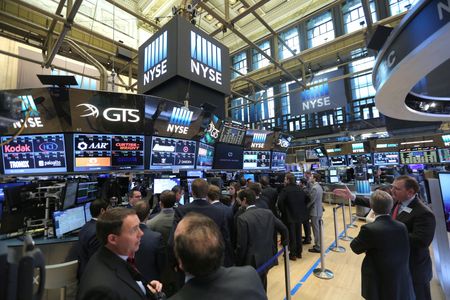By Dhara Ranasinghe and Koh Gui Qing
NEW YORK/LONDON (Reuters) -Caution took hold of world markets on Tuesday, with the dollar and equities gyrating in choppy trade and gold briefly hitting a record high on concern a likely U.S. government shutdown could delay key jobs data.
President Donald Trump said the United States is probably headed towards its 15th government shutdown since 1981, and that his administration could make irreversible changes in such a scenario.
The dollar was broadly weaker while U.S. stocks managed to erase early losses and close slightly higher, as investors prepared for a shutdown to begin once a midnight deadline to craft a new funding deal has passed.
PROSPECT OF U.S. SHUTDOWN PUTS SPOTLIGHT ON JOBS
A government closure would delay the issue this Friday of key employment numbers, putting the spotlight on Tuesday’s JOLTS report from the Department of Labor which showed that U.S. job openings increased marginally in August while hiring declined.
This was consistent with lackluster labor market conditions that could allow the Federal Reserve to cut interest rates again next month despite resilient consumer spending.
“A full government shutdown on October 1 appears increasingly likely,” said Monica Guerra, head of U.S. policy at Morgan Stanley Wealth Management.
U.S. stocks nursed modest losses for most of the day before eking out gains in the final hours of trade. The S&P 500 rose 0.4%, the Dow Jones Industrial Average inched up 0.2%, and the Nasdaq Composite gained 0.3%. Wall Street’s gains on Tuesday capped a spectacular month of performance for U.S. stocks. The S&P 500’s September performance – a gain of 3.5% – was the best in any September since 2010.
The late spurt in U.S. stocks helped to lift the MSCI All-World index 0.4% higher.
Across the Atlantic, the pan-European STOXX 600 also reversed earlier losses to rise 0.5%, helped by gains in industrial and healthcare stocks, while Japan’s Nikkei closed down 0.25%. For the month, the STOXX 600 was up 1%, its best monthly performance since May.
“We’ve actually just decided to increase our weightings in equities further,” said Shaniel Ramjee, co-head of multi-asset at Pictet Asset Management.
“The earnings picture has recovered quite materially at the same time that global central banks are still cutting interest rates and global growth is fine.”
Australia’s dollar added to gains after the central bank held policy rates unchanged, as widely expected. Oil prices fell more than 1% on prospects of greater production by OPEC+, while China’s manufacturing activity shrank for a sixth month in September.
A SHINING MONTH FOR GOLD
Risks of a shutdown added to gold’s stunning rally. It briefly hit a record high of $3,871.45 per ounce before trading lower on the day. It has gained more than 10% in September, on track for its biggest monthly percentage gain since July 2020.
Meanwhile the dollar was down 0.5% at 147.9 yen, the euro was flat at $1.17355, and the Swiss franc and pound were a touch firmer against the dollar.
The dollar index was last down 0.1% on the day and set to end September little changed on the month.
The yen could emerge as an outperformer as a hedge to a U.S. government shutdown, ING currency analysts said in a note.
The September employment report due Friday is considered key to the Fed’s calculations for the timing of rate cuts.
A protracted government closure could leave the Fed flying blind on the economy when it meets on October 29, however.
China’s purchasing managers’ index rose to 49.8 in September from 49.4 in August, below the 50-mark separating growth from contraction.
It suggested producers are waiting for further stimulus to boost domestic demand, as well as clarity on a U.S. trade deal.
China’s blue-chip CSI300 Index rose almost 0.5%, for a fifth straight month of gains and its longest such streak since October 2017.
The Reserve Bank of Australia left its cash rate steady at 3.60%, saying recent data suggested inflation might be higher than forecast in the third quarter and that the economic outlook remained uncertain.
In Europe, data showing inflation rising in four key German states had limited market impact.
Oil stayed weaker due to an anticipated production increase by OPEC+ and the resumption of oil exports from Iraq’s Kurdistan region. Brent slipped 1.3% to $67.10 per barrel and U.S. crude fell 1.5% to $62.51.
(Reporting by Dhara Ranasinghe in London and Rocky Swift in Tokyo; additional reporting by Naomi Rovnick in London. Editing by Mark Potter, Nick Zieminski and Edmund Klamann)











